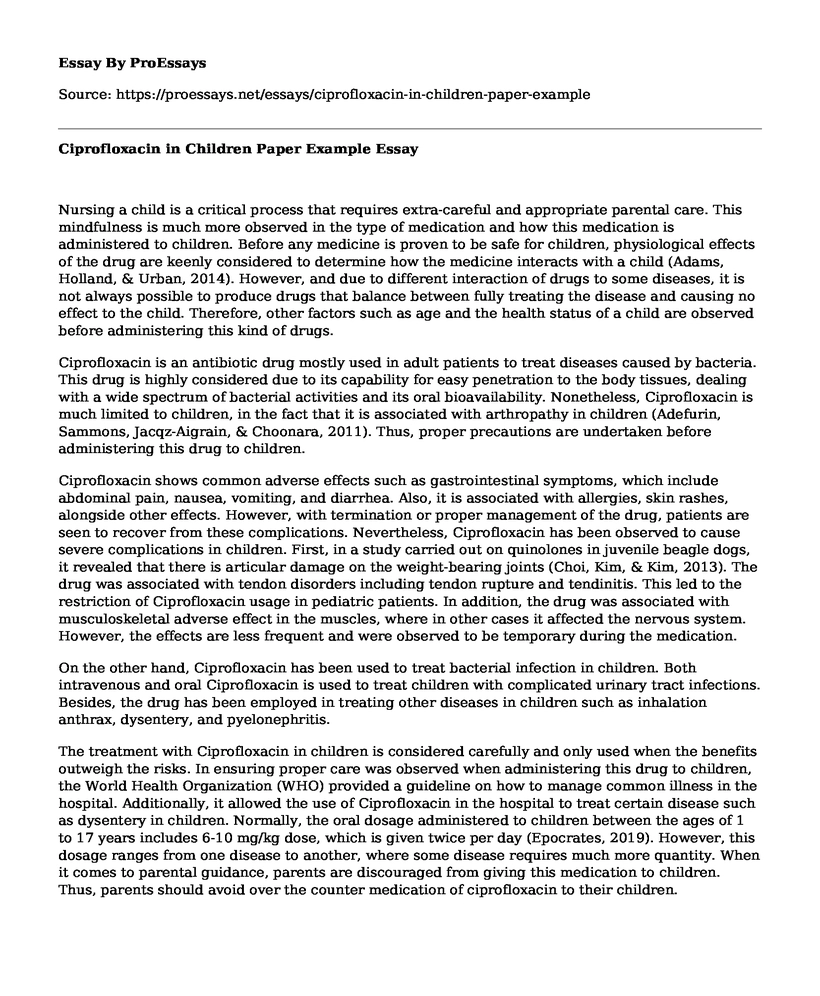Nursing a child is a critical process that requires extra-careful and appropriate parental care. This mindfulness is much more observed in the type of medication and how this medication is administered to children. Before any medicine is proven to be safe for children, physiological effects of the drug are keenly considered to determine how the medicine interacts with a child (Adams, Holland, & Urban, 2014). However, and due to different interaction of drugs to some diseases, it is not always possible to produce drugs that balance between fully treating the disease and causing no effect to the child. Therefore, other factors such as age and the health status of a child are observed before administering this kind of drugs.
Ciprofloxacin is an antibiotic drug mostly used in adult patients to treat diseases caused by bacteria. This drug is highly considered due to its capability for easy penetration to the body tissues, dealing with a wide spectrum of bacterial activities and its oral bioavailability. Nonetheless, Ciprofloxacin is much limited to children, in the fact that it is associated with arthropathy in children (Adefurin, Sammons, Jacqz-Aigrain, & Choonara, 2011). Thus, proper precautions are undertaken before administering this drug to children.
Ciprofloxacin shows common adverse effects such as gastrointestinal symptoms, which include abdominal pain, nausea, vomiting, and diarrhea. Also, it is associated with allergies, skin rashes, alongside other effects. However, with termination or proper management of the drug, patients are seen to recover from these complications. Nevertheless, Ciprofloxacin has been observed to cause severe complications in children. First, in a study carried out on quinolones in juvenile beagle dogs, it revealed that there is articular damage on the weight-bearing joints (Choi, Kim, & Kim, 2013). The drug was associated with tendon disorders including tendon rupture and tendinitis. This led to the restriction of Ciprofloxacin usage in pediatric patients. In addition, the drug was associated with musculoskeletal adverse effect in the muscles, where in other cases it affected the nervous system. However, the effects are less frequent and were observed to be temporary during the medication.
On the other hand, Ciprofloxacin has been used to treat bacterial infection in children. Both intravenous and oral Ciprofloxacin is used to treat children with complicated urinary tract infections. Besides, the drug has been employed in treating other diseases in children such as inhalation anthrax, dysentery, and pyelonephritis.
The treatment with Ciprofloxacin in children is considered carefully and only used when the benefits outweigh the risks. In ensuring proper care was observed when administering this drug to children, the World Health Organization (WHO) provided a guideline on how to manage common illness in the hospital. Additionally, it allowed the use of Ciprofloxacin in the hospital to treat certain disease such as dysentery in children. Normally, the oral dosage administered to children between the ages of 1 to 17 years includes 6-10 mg/kg dose, which is given twice per day (Epocrates, 2019). However, this dosage ranges from one disease to another, where some disease requires much more quantity. When it comes to parental guidance, parents are discouraged from giving this medication to children. Thus, parents should avoid over the counter medication of ciprofloxacin to their children.
Conclusion
In conclusion, Ciprofloxacin has several adverse effects on children. Nonetheless, the drug is very beneficial in treating different types of disease such as urinary tract infections, inhalation anthrax among others. However, physicians are advised to considered use of ciprofloxacin only when pediatric patients are not responding to normal therapy treatment and when they are infected with multidrug-resistant pathogens.
References
Adams, M., Holland, L., & Urban, C. (2014). Drug Administration Throughout the Life Span. In Pharmacology for Nurses: A Pathophysiologic Approach Plus MyNursingLab with Pearson EText -- Access Card Package (4th ed., pp. 80-84). London, England: Pearson.
Adefurin, A., Sammons, H., Jacqz-Aigrain, E., & Choonara, I. (2011). Ciprofloxacin safety in paediatrics: a systematic review. Archives Of Disease In Childhood, 96(9), 874-880. doi: 10.1136/adc.2010.208843
Choi, S., Kim, E., & Kim, Y. (2013). Systemic use of fluoroquinolone in children. Korean Journal Of Pediatrics, 56(5), 196. doi: 10.3345/kjp.2013.56.5.196
Epocrates. (2019). Cipro Pediatric Dosing - Epocrates Online. Retrieved from https://online.epocrates.com/drugs/50202/Cipro/Peds-Dosing
Cite this page
Ciprofloxacin in Children Paper Example. (2022, Nov 20). Retrieved from https://proessays.net/essays/ciprofloxacin-in-children-paper-example
If you are the original author of this essay and no longer wish to have it published on the ProEssays website, please click below to request its removal:
- Speech Example on Few Male Nurses: Examining the Controversy
- Essay on 3 Qualities of Affordable, Sustainable Health Systems
- Essay Example on 400K Lives Lost: The Opioid Crisis in America
- Paper Example on Pain Mgt: ANA, Joint Comm. Codes Provide Optimal Care
- Social Work Code of Ethics: The NASW Standards of Professional Conduct - Essay Sample
- Nightingale Community Hospital: Tracer Patient's Service Quality Analysis - Essay Sample
- Nutrition Interventions & Global Health: Improving Worldwide Health - Free Essay Example







